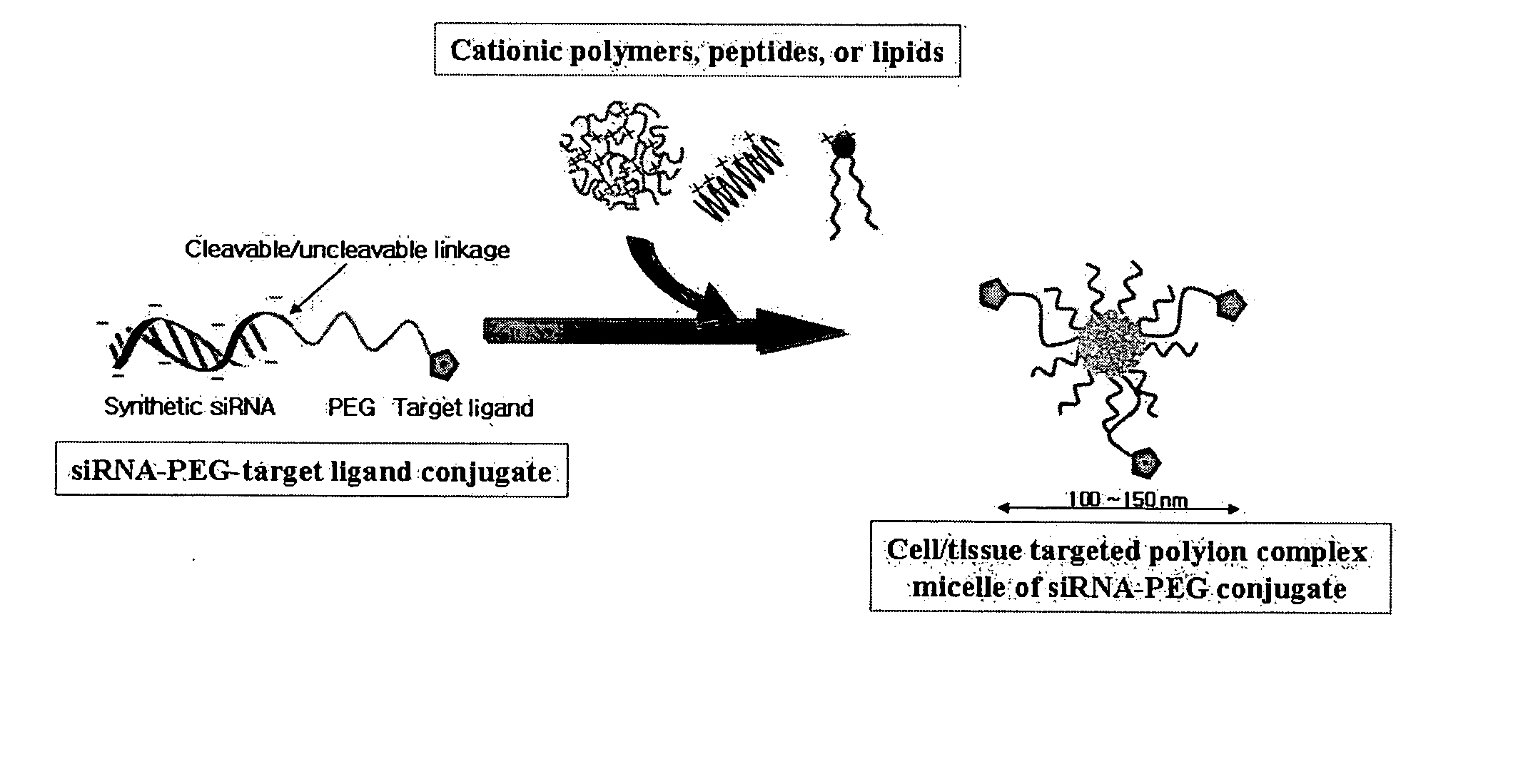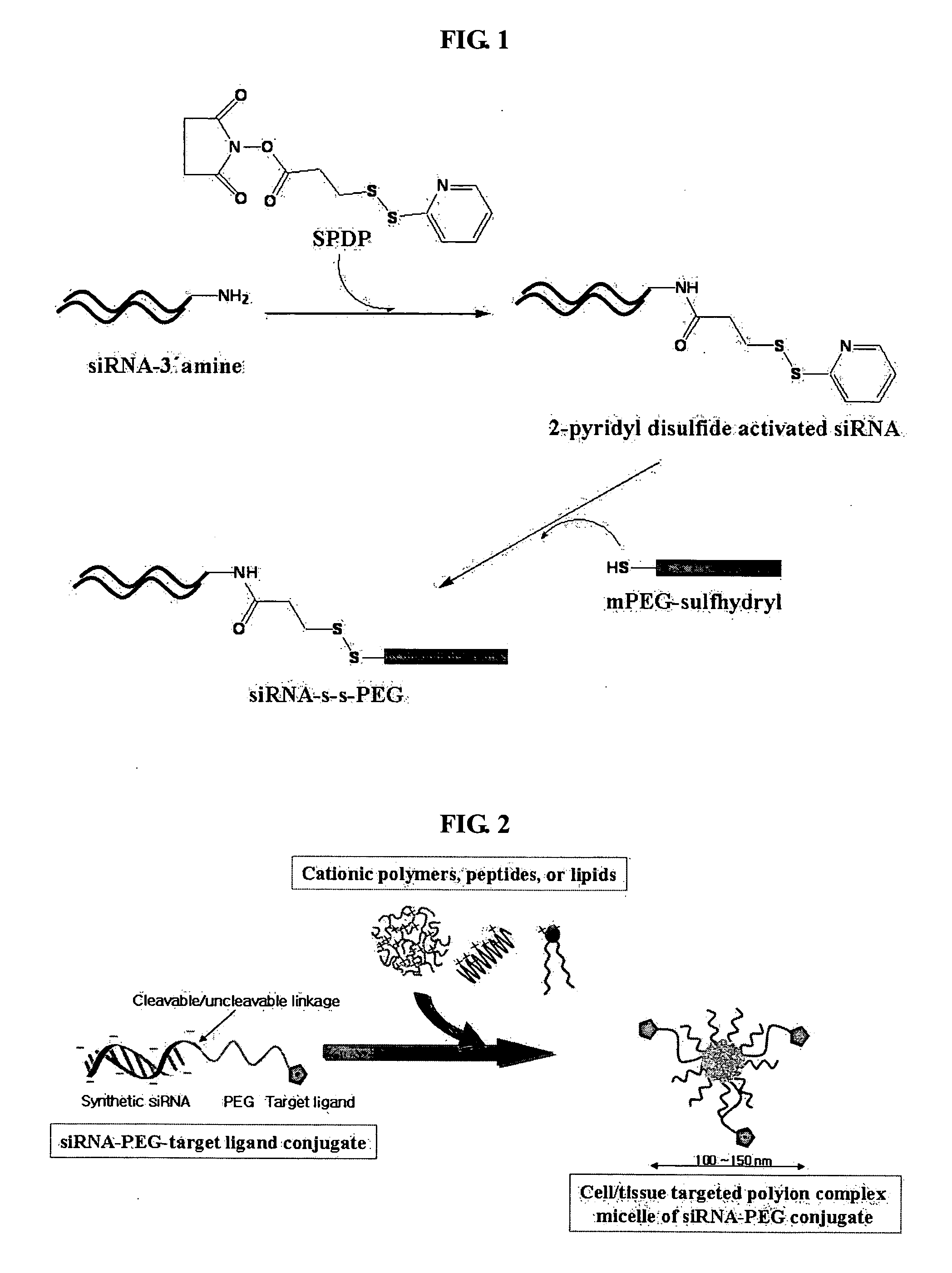siRNA-hydrophilic polymer conjugates for intracellular delivery of siRNA and method thereof
- Summary
- Abstract
- Description
- Claims
- Application Information
AI Technical Summary
Benefits of technology
Problems solved by technology
Method used
Image
Examples
example 1
Synthesis of siRNA-PEG Conjugate Containing Biodegradable Disulfide Bond
[0084] For Examples herein below, a hVEGF (human vascular endothelial growth factor) siRNA was used. A target sequence of the hVEGF siRNA is represented by SEQ ID NO: 1 (hVEGF, 189-207 bp), a sense strand of the hVEGF siRNA is represented by SEQ ID NO: 2, and an antisense strand of the hVEGF siRNA is represented by SEQ ID NO: 3. In addition, a sense strand of scrambled siRNA is represented by SEQ ID NO: 4, and an antisense strand of the scrambled siRNA is represented by SEQ ID NO: 5.
[0085] Using an siRNA introduced an amine group at the 3′ end of the sense strand of the siRNA (Qiangen Inc.) and SPDP which is a heterobifunctional and cleavable cross linker, a pyridyldithiol-activated siRNA intermediate (the amine at the end is activated to a pyridyldithiol group) was synthesized. First, 300 μg of the siRNA (20 mmol) dissolved in 800 μl of 5 mM phosphate buffer (pH=7.5) was mixed with 20 μl of 20 mM SPDP dissolv...
example 2
Synthesis of siRNA-PEG Conjugate Containing Non-Cleavable Linkage into which Cancer Cell Selective Ligand is Introduced
[0087] In order to introduce PEG having a cancer cell selective ligand into an siRNA through a non-cleavable linkage, an siRNA having an amine group (—NH2) at the 3′ end of the sense strand was used. First, 130 mg of folate (0.3 mmole) was dissolved in DMSO, and was mixed with 60 mg DCC (dicyclohexyl carbodiimide) and 34 mg of NHS (N-hydroxyl succinimide). The reaction was carried out at room temperature for 30 minutes, resulting in the activation of the carboxyl group of the folate. 34 mg of cystamine was added to the mixture and the reaction kept up for an additional 3 hours. At this time, the reaction molar stoichiometry between folate and cystamine was 2:1. The reactant thus obtained was dialyzed with water and any unreacted byproduct was removed. The reactant was then lyophilized. Next, cystamine-folate-cystamine (cystamine-FOL2) was dissolved in aqueous DMSO ...
example 3
Formation of siRNA-PEG / KALA Polyelectrolyte Complex Micelle and its Characterization (1)
[0088] To obtain a gene transfer vehicle capable of transferring the siRNA-PEG conjugate synthesized and isolated in Example 1 to target cells, polyelectrolyte complex micelles were prepared using a cationic peptide such as KALA (Peptrone, Korea) or protamine (Sigma-Aldrich, USA), a cationic polymer such as PEI (Sigma-Aldrich, USA), or a cationic lipid such as dioleylphosphatidyl choline (DOPC, Nutfield, UK) and the like. Herein, formation of polyelectrolyte complex micelles using KALA is suggested as an example with detailed description, as follows. First, the siRNA-PEG conjugate (50 pmol) was diluted in an equal volume of 2×(PBS), and KALA dissolved in PBS was then added to the diluted conjugate to form polyelectrolyte complex micelles, followed by incubation at room temperature for 15 min to stabilize the formed micelles, wherein the ratio of positive charge of the KALA peptide to negative ch...
PUM
| Property | Measurement | Unit |
|---|---|---|
| Molecular weight | aaaaa | aaaaa |
| Hydrophilicity | aaaaa | aaaaa |
| Stability | aaaaa | aaaaa |
Abstract
Description
Claims
Application Information
 Login to View More
Login to View More - R&D
- Intellectual Property
- Life Sciences
- Materials
- Tech Scout
- Unparalleled Data Quality
- Higher Quality Content
- 60% Fewer Hallucinations
Browse by: Latest US Patents, China's latest patents, Technical Efficacy Thesaurus, Application Domain, Technology Topic, Popular Technical Reports.
© 2025 PatSnap. All rights reserved.Legal|Privacy policy|Modern Slavery Act Transparency Statement|Sitemap|About US| Contact US: help@patsnap.com



